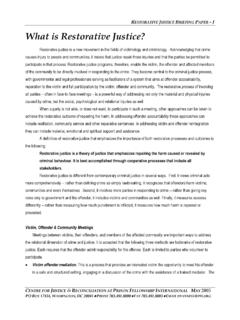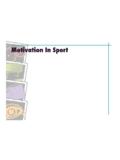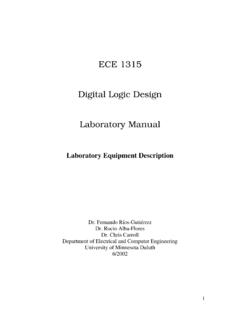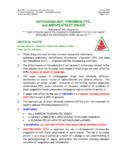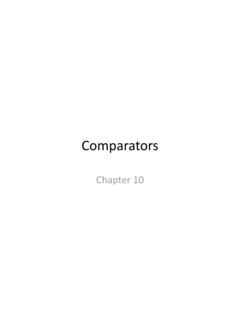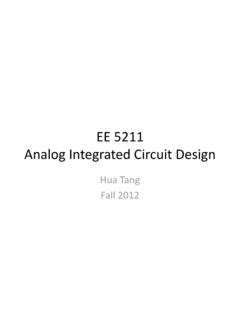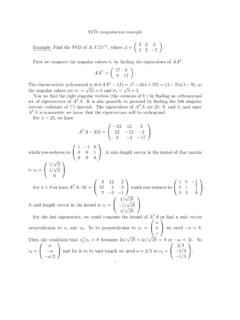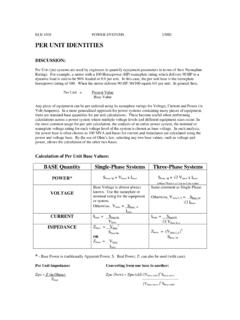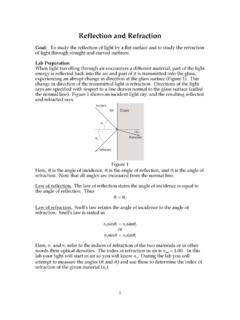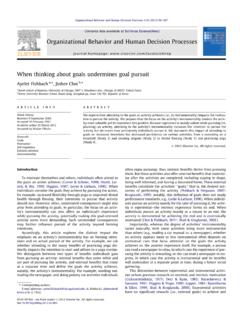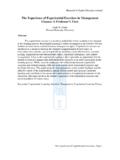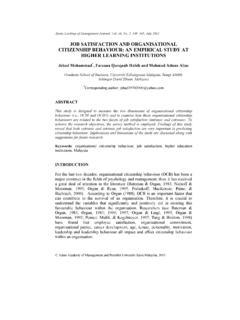Transcription of Experiential Learning Theory - University of …
1 Experiential Learning Theory : Previous Research and New Directions David A. Kolb Richard E. Boyatzis Charalampos Mainemelis Department of organizational behavior Weatherhead School of Management Case Western Reserve University 10900 Euclid Avenue, Cleveland, OH 44106 PH: (216) 368 -2050 FAX: (216) 368-4785 August 31, 1999 The revised paper appears in: R. J. Sternberg and L. F. Zhang (Eds.), Perspectives on cognitive, Learning , and thinking styles. NJ: Lawrence Erlbaum, 2000. 2 Experiential Learning Theory : Previous Research and New Directions Experiential Learning Theory (ELT) provides a holistic model of the Learning process and a multilinear model of adult development, both of which are consistent with what we know about how people learn, grow, and develop. The Theory is called Experiential Learning to emphasize the central role that experience plays in the Learning process, an emphasis that distinguishes ELT from other Learning theories. The term Experiential is used therefore to differentiate ELT both from cognitive Learning theories, which tend to emphasize cognition over affect, and behavioral Learning theories that deny any role for subjective experience in the Learning process.
2 Another reason the Theory is called Experiential is its intellectual origins in the Experiential works of Dewey, Lewin, and Piaget. Taken together, Dewey s philosophical pragmatism, Lewin s social psychology, and Piaget s cognitive-developmental genetic epistemology form a unique perspective on Learning and development. (Kolb, 1984). The Experiential Learning Model and Learning Styles Experiential Learning Theory defines Learning as "the process whereby knowledge is created through the transformation of experience. Knowledge results from the combination of grasping and transforming experience"(Kolb 1984, p. 41). The ELT model portrays two dialectically related modes of grasping 3 experience -- Concrete Experience (CE) and Abstract Conceptualization (AC) -- and two dialectically related modes of transforming experience -- Reflective Observation (RO) and Active Experimentation (AE). According to the four-stage Learning cycle depicted in Figure 1, immediate or concrete experiences are the basis for observations and reflections.
3 These reflections are assimilated and distilled into abstract concepts from which new implications for action can be drawn. These implications can be actively tested and serve as guides in creating new experiences. ------------------------------- Insert Figure 1 about here ------------------------------- A closer examination of the ELT Learning model suggests that Learning requires abilities that are polar opposites, and that the learner must continually choose which set of Learning abilities he or she will use in a specific Learning situation. In grasping experience some of us perceive new information through experiencing the concrete, tangible, felt qualities of the world, relying on our senses and immersing ourselves in concrete reality. Others tend to perceive, grasp, or take hold of new information through symbolic representation or abstract conceptualization thinking about, analyzing, or systematically planning, rather than using sensation as a guide. Similarly, in transforming or processing experience some of us tend to carefully watch others who are involved in the 4 experience and reflect on what happens, while others choose to jump right in and start doing things.
4 The watchers favor reflective observation, while the doers favor active experimentation. Each dimension of the Learning process presents us with a choice. Since it is virtually impossible, for example, to simultaneously drive a car (Concrete Experience) and analyze a driver s manual about the car s functioning (Abstract Conceptualization), we resolve the conflict by choosing. Because of our hereditary equipment, our particular past life experiences, and the demands of our present environment, we develop a preferred way of choosing. We resolve the conflict between concrete or abstract and between active or reflective in some patterned, characteristic ways. We call these patterned ways Learning styles. The Learning Style Inventory and the Four Basic Learning Styles In 1971 David Kolb developed the Learning Style Inventory (LSI) to assess individual Learning styles. While individuals tested on the LSI show many different patterns of scores, research on the instrument has identified four statistically prevalent Learning styles -- Diverging, Assimilating, Converging, and Accommodating (Figure 1).
5 The following summary of the four basic Learning styles is based on both research and clinical observation of these patterns of LSI scores (Kolb, 1984, 1999a, 1999b). 5 Diverging. The Diverging style s dominant Learning abilities are Concrete Experience (CE) and Reflective Observation (RO). People with this Learning style are best at viewing concrete situations from many different points of view. It is labeled Diverging because a person with it performs better in situations that call for generation of ideas, such as a brainstorming session. People with a Diverging Learning style have broad cultural interests and like to gather information. Research shows that they are interested in people, tend to be imaginative and emotional, have broad cultural interests, and tend to specialize in the arts. In formal Learning situations, people with the Diverging style prefer to work in groups, listening with an open mind and receiving personalized feedback. Assimilating. The Assimilating style s dominant Learning abilities are Abstract Conceptualization (AC) and Reflective Observation (RO).
6 People with this Learning style are best at understanding a wide range of information and putting into concise, logical form. Individuals with an Assimilating style are less focused on people and more interested in ideas and abstract concepts. Generally, people with this style find it more important that a Theory have logical soundness than practical value. The Assimilating Learning style is important for effectiveness in information and science careers. In formal Learning situations, people with this style prefer readings, lectures, exploring analytical models, and having time to think things through. 6 Converging. The Converging style s dominant Learning abilities are Abstract Conceptualization (AC) and Active Experimentation (AE). People with this Learning style are best at finding practical uses for ideas and theories. They have the ability to solve problems and make decisions based on finding solutions to questions or problems. Individuals with a Converging Learning style prefer to deal with technical tasks and problems rather than with social issues and interpersonal issues.
7 These Learning skills are important for effectiveness in specialist and technology careers. In formal Learning situations, people with this style prefer to experiment with new ideas, simulations, laboratory assignments, and practical applications. Accommodating. The Accommodating style s dominant Learning abilities are Concrete Experience (CE) and Active Experimentation (AE). People with this Learning style have the ability to learn from primarily hand-on experience. They enjoy carrying out plans and involving themselves in new and challenging experiences. Their tendency may be to act on gut feelings rather than on logical analysis. In solving problems, individuals with an Accommodating Learning style rely more heavily on people for information than on their own technical analysis. This Learning style is important for effectiveness in action-oriented careers such as marketing or sales. In formal Learning situations, people with the Accommodating Learning style prefer to work with others to get assignments 7 done, to set goals, to do field work, and to test out different approaches to completing a project.
8 Factors that Shape and Influence Learning Styles The above patterns of behavior associated with the four basic Learning styles are shown consistently at various levels of behavior . During the last three decades researchers have examined the characteristics of Learning styles at five particular levels of behavior : Personality types, early educational specialization, professional career, current job role, and adaptive competencies. We summarize briefly these research findings in Table 1 and discuss them below. -------------------------------- Insert Table 1 about here -------------------------------- Personality Types. ELT follows Carl Jung in recognizing that Learning styles result from individuals preferred ways for adapting in the world. Jung s Extraversion/Introversion dialectical dimension as measured by the Myers-Briggs Type Indicator (MBTI) correlates with the Active/Reflective dialectic of ELT as measured by the LSI; and the MBTI Feeling/Thinking dimension correlates with the LSI Concrete Experience/ Abstract Conceptualization dimension.
9 The MBTI Sensing type is associated with the LSI Accommodating Learning style and the MBTI Intuitive type with the LSI Assimilating style. MBTI Feeling types 8 correspond to LSI Diverging Learning styles and Thinking types to Converging styles. The above discussion implies that the Accommodating Learning style is the Extraverted Sensing type, and the Converging style the Extraverted Thinking type. The Assimilating Learning style corresponds to the Introverted Intuitive personality type and the Diverging style to the Introverted Feeling type. Myers (1962) descriptions of these MBTI types are very similar to the corresponding LSI Learning styles as described by ELT (see also Kolb, 1984, pp: 83-85). Educational Specialization. Early educational experiences shape people s individual Learning styles by instilling positive attitudes toward specific sets of Learning skills and by teaching students how to learn. Although elementary education is generalized, there is an increasing process of specialization that begins at high school and becomes sharper during the college years.
10 This specialization in the realms of social knowledge influences individuals orientations toward Learning , resulting to particular relations between Learning styles and early training in an educational specialty or discipline. People with undergraduate majors in the Arts, History, Political science, English, and Psychology tend to have Diverging Learning styles, while those majoring in more abstract and applied areas like Physical Sciences and Engineering have Converging Learning styles. Individuals with Accommodating 9 styles have educational backgrounds in Business and Management, and those with Assimilating styles in Economics, Mathematics, Sociology, and Chemistry. Professional Career Choice. A third set of factors that shape Learning styles stems from professional careers. One s professional career choice not only exposes one to a specialized Learning environment, but it also involves a commitment to a generic professional problem, such as social service, that requires a specialized adaptive orientation.
